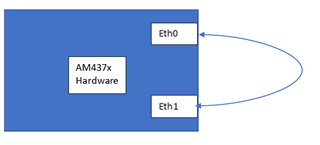Other Parts Discussed in Thread: AM4378
On our hardware we are trying to ping eth0 from eth1 (loopback) for board level functional testing, but I am not able to ping eth0 from eth1 or vice versa.
Note:
- I also have tried same test on AM4378 SK EVM, with the default images present on SD card. On SK EMV also I am not able to ping eth0 from eth1 (loopback) or vice versa.
- I am able to ping to PC/laptop from eth0/eth1.
See following block diagram illustrating the Ethernet cable connection.

Following is eth0 and eth1 configurations and ping command results:
|
root@picv6-1:~# [ 275.209337] cpsw 4a100000.ethernet eth1: Link is Down [ 279.849350] cpsw 4a100000.ethernet eth0: Link is Down [ 286.089616] cpsw 4a100000.ethernet eth0: Link is Up - 100Mbps/Full - flow control off [ 286.169688] cpsw 4a100000.ethernet eth1: Link is Up - 100Mbps/Full - flow control off
root@picv6-1:~# ifconfig -a eth0 Link encap:Ethernet HWaddr 14:42:FC:D2:84:61 inet addr:192.168.1.100 Bcast:192.168.1.255 Mask:255.255.255.0 inet6 addr: 2001:db8::1642:fcff:fed2:8461/128 Scope:Global inet6 addr: fe80::1642:fcff:fed2:8461/64 Scope:Link UP BROADCAST RUNNING PROMISC MULTICAST MTU:1500 Metric:1 RX packets:177 errors:0 dropped:3 overruns:0 frame:0 TX packets:43 errors:0 dropped:0 overruns:0 carrier:0 collisions:0 txqueuelen:3000 RX bytes:22610 (22.0 KiB) TX bytes:9169 (8.9 KiB) Interrupt:48
eth1 Link encap:Ethernet HWaddr 14:42:FC:D2:84:63 inet addr:192.168.2.100 Bcast:192.168.2.255 Mask:255.255.255.0 inet6 addr: fe80::1642:fcff:fed2:8463/64 Scope:Link inet6 addr: 2001:db8::1642:fcff:fed2:8463/128 Scope:Global UP BROADCAST RUNNING PROMISC MULTICAST MTU:1500 Metric:1 RX packets:182 errors:0 dropped:3 overruns:0 frame:0 TX packets:45 errors:0 dropped:0 overruns:0 carrier:0 collisions:0 txqueuelen:3000 RX bytes:23611 (23.0 KiB) TX bytes:9307 (9.0 KiB)
lo Link encap:Local Loopback inet addr:127.0.0.1 Mask:255.0.0.0 inet6 addr: ::1/128 Scope:Host inet6 addr: 2001:db8::200:ff:fe00:0/128 Scope:Global UP LOOPBACK RUNNING PROMISC MTU:65536 Metric:1 RX packets:2 errors:0 dropped:0 overruns:0 frame:0 TX packets:2 errors:0 dropped:0 overruns:0 carrier:0 collisions:0 txqueuelen:3000 RX bytes:140 (140.0 B) TX bytes:140 (140.0 B)
sit0 Link encap:IPv6-in-IPv4 NOARP MTU:1480 Metric:1 RX packets:0 errors:0 dropped:0 overruns:0 frame:0 TX packets:0 errors:0 dropped:0 overruns:0 carrier:0 collisions:0 txqueuelen:1000 RX bytes:0 (0.0 B) TX bytes:0 (0.0 B)
wlan0 Link encap:Ethernet HWaddr 30:EB:1F:1D:A9:9A UP BROADCAST PROMISC MULTICAST MTU:1500 Metric:1 RX packets:0 errors:0 dropped:0 overruns:0 frame:0 TX packets:0 errors:0 dropped:0 overruns:0 carrier:0 collisions:0 txqueuelen:3000 RX bytes:0 (0.0 B) TX bytes:0 (0.0 B)
root@picv6-1:~# netstat -rn Kernel IP routing table Destination Gateway Genmask Flags MSS Window irtt Iface 192.168.1.0 0.0.0.0 255.255.255.0 U 0 0 0 eth0 192.168.2.0 0.0.0.0 255.255.255.0 U 0 0 0 eth1 root@picv6-1:~# ping -I eth0 192.168.2.100 PING 192.168.2.100 (192.168.2.100) from 192.168.1.100 eth0: 56(84) bytes of data. ^C --- 192.168.2.100 ping statistics --- 15 packets transmitted, 0 received, 100% packet loss, time 558ms pipe 3 root@picv6-1:~# ping -I eth1 192.168.1.100 PING 192.168.1.100 (192.168.1.100) from 192.168.2.100 eth1: 56(84) bytes of data. ^C --- 192.168.1.100 ping statistics --- 9 packets transmitted, 0 received, 100% packet loss, time 346ms pipe 3 |
We are using processor SDK 06_03_00_106, while going through CPSW driver section I came across following constraints while using dual standalone emac mode:
|
Constraints
The following are the constrains for Dual emac mode implementation
|
I have following questions:
- Is it possible to ping from eth0 to eth1 in dual MAC configuration with Am437x.
- Do I have to configure eth0 and eth1 in specific way to make this work?
- I don’t completely understand this constraint “Both the interfaces should not be connected to the same subnet unless only configuring bridging, and not doing IP routing, then you can configure the two interfaces on the same subnet". As my eth0 and eth1 are on same subnet is that stopping me from pinging from eth1 to eth0 and vice versa.


